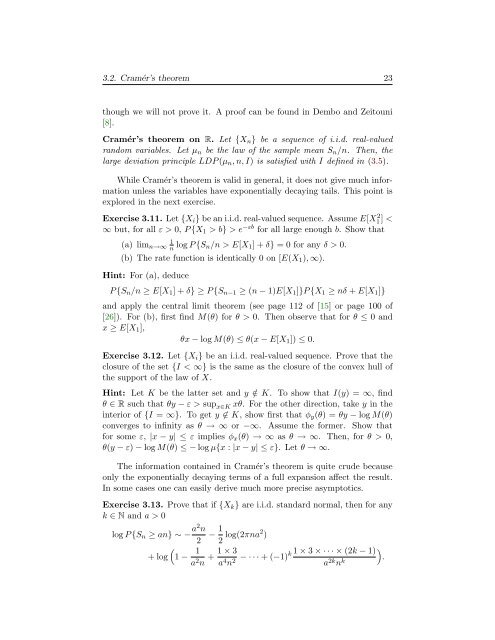A Course on Large Deviations with an Introduction to Gibbs Measures.
A Course on Large Deviations with an Introduction to Gibbs Measures.
A Course on Large Deviations with an Introduction to Gibbs Measures.
You also want an ePaper? Increase the reach of your titles
YUMPU automatically turns print PDFs into web optimized ePapers that Google loves.
3.2. Cramér’s theorem 23<br />
though we will not prove it. A proof c<strong>an</strong> be found in Dembo <strong>an</strong>d Zei<strong>to</strong>uni<br />
[8].<br />
Cramér’s theorem <strong>on</strong> R. Let {Xn} be a sequence of i.i.d. real-valued<br />
r<strong>an</strong>dom variables. Let µn be the law of the sample me<strong>an</strong> Sn/n. Then, the<br />
large deviati<strong>on</strong> principle LDP (µn, n, I) is satisfied <strong>with</strong> I defined in (3.5).<br />
While Cramér’s theorem is valid in general, it does not give much informati<strong>on</strong><br />
unless the variables have exp<strong>on</strong>entially decaying tails. This point is<br />
explored in the next exercise.<br />
Exercise 3.11. Let {Xi} be <strong>an</strong> i.i.d. real-valued sequence. Assume E[X 2 1 ] <<br />
∞ but, for all ε > 0, P {X1 > b} > e−εb for all large enough b. Show that<br />
(a) limn→∞ 1<br />
n log P {Sn/n > E[X1] + δ} = 0 for <strong>an</strong>y δ > 0.<br />
(b) The rate functi<strong>on</strong> is identically 0 <strong>on</strong> [E(X1), ∞).<br />
Hint: For (a), deduce<br />
P {Sn/n ≥ E[X1] + δ} ≥ P {Sn−1 ≥ (n − 1)E[X1]}P {X1 ≥ nδ + E[X1]}<br />
<strong>an</strong>d apply the central limit theorem (see page 112 of [15] or page 100 of<br />
[26]). For (b), first find M(θ) for θ > 0. Then observe that for θ ≤ 0 <strong>an</strong>d<br />
x ≥ E[X1],<br />
θx − log M(θ) ≤ θ(x − E[X1]) ≤ 0.<br />
Exercise 3.12. Let {Xi} be <strong>an</strong> i.i.d. real-valued sequence. Prove that the<br />
closure of the set {I < ∞} is the same as the closure of the c<strong>on</strong>vex hull of<br />
the support of the law of X.<br />
Hint: Let K be the latter set <strong>an</strong>d y /∈ K. To show that I(y) = ∞, find<br />
θ ∈ R such that θy − ε > sup x∈K xθ. For the other directi<strong>on</strong>, take y in the<br />
interior of {I = ∞}. To get y ∈ K, show first that φy(θ) = θy − log M(θ)<br />
c<strong>on</strong>verges <strong>to</strong> infinity as θ → ∞ or −∞. Assume the former. Show that<br />
for some ε, |x − y| ≤ ε implies φx(θ) → ∞ as θ → ∞. Then, for θ > 0,<br />
θ(y − ε) − log M(θ) ≤ − log µ{x : |x − y| ≤ ε}. Let θ → ∞.<br />
The informati<strong>on</strong> c<strong>on</strong>tained in Cramér’s theorem is quite crude because<br />
<strong>on</strong>ly the exp<strong>on</strong>entially decaying terms of a full exp<strong>an</strong>si<strong>on</strong> affect the result.<br />
In some cases <strong>on</strong>e c<strong>an</strong> easily derive much more precise asymp<strong>to</strong>tics.<br />
Exercise 3.13. Prove that if {Xk} are i.i.d. st<strong>an</strong>dard normal, then for <strong>an</strong>y<br />
k ∈ N <strong>an</strong>d a > 0<br />
log P {Sn ≥ <strong>an</strong>} ∼ − a2n 1<br />
−<br />
2 2 log(2πna2 )<br />
<br />
+ log 1 − 1<br />
a2 1 × 3<br />
+<br />
n a4 1 × 3 × · · · × (2k − 1)<br />
− · · · + (−1)k<br />
n2 a2knk <br />
.
















